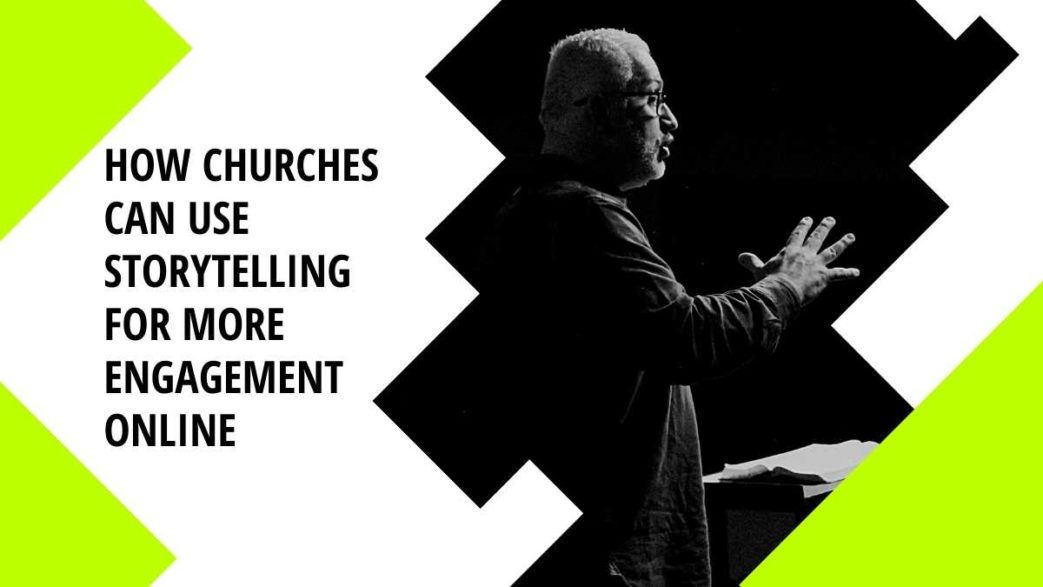Expanding your reach and increasing engagement means more marketing, right? Not exactly. Instead, try storytelling.
It’s a much more relatable approach to reaching people online, even those who aren’t sure your church is right for them.
Brands and nonprofits everywhere are embracing this technique. Think of it as part marketing, part relationship building. The most important thing is it works.

Understanding Storytelling
If your first thought was reading a bedtime story to a child, you’re not far off. Storytelling in terms of marketing is about telling stories that are relevant to your brand, or in this case your church. Instead of just writing a page of content, you tell a story much like you would to a friend or relative.
Yoast explains storytelling more in-depth, but at its core, it’s all about taking facts and turning them into an engaging story. People tend to remember stories much easier than just random facts, such as a list of details about your church. The story about how and why you created your church would be much more memorable.
HubSpot takes a different approach. Instead of calling it a technique, they call it an art. Why? Because it involves creativity and practice to master.
That’s something to keep in mind. Most people aren’t master storytellers from day one. It takes practice. You’ll need to listen to your audience and know what your audience wants to tell the types of stories that will mean the most to them.
Explain How You Got Here
Your church doesn’t have to write a book. After all, you’re busy enough with all your other responsibilities. Storytelling can become a part of most any content on your church website, social media platforms, videos, etc.
The best place to start is with your About Us page. When people find your church online, they want to know what makes it different. They want to know it’s not just another church, but something special and a place they’d love to call home.
Many About Us pages give a generic message. It covers when the church started, how many members there are, the denomination and a mission statement. Nothing about that sets a church apart or draws people in.
Instead, tell a story – your church’s story. Forget about being formal. Be personable. Think back to how it felt from the moment you decided to start a new church. What was your motivation? What is it about this church that makes it different?
Talk about the journey. Get insights from your founding members. And finish up by saying that your church’s story is still unfolding with every new member. This is a welcoming way to encourage people to try your church and be part of the story.
Don’t forget, a story doesn’t have to just be text. Add a video where the founding members all tell the story together. If you’re just starting a new church, document the process and create a final video for your About Us page.
Bring Members’ Stories To Life
Everyone can be a storyteller. After all, everyone has their own story and journey to talk about. When storytelling works so well, why aren’t more people using it? It’s not always easy to come up with new stories. Writing a factual, informative blog post seems like a breeze compared to an engaging story.
However, you don’t have to just come up with something. Every member and visitor has a story as to how they got there. Ask them to share those stories with you.
Be honest. If you’re looking for a new church, which of the following would motivate you to try a particular church:
A) The church website says the church can help change your life and bring you closer to God.
Or
B) A member tells a story about losing their way and struggling with their life. A friend convinces them to join them at church one Sunday. The pastor’s message resonated with them and several months later, they’ve become a part of a supportive community that’s help them get back on track and feel better than ever.
Most people would choose the option B. It comes from a real person that’s just sharing how the church helped them. It’s not any type of marketing message, but a genuine story. This is more authentic, trust-worthy and relatable.

Embrace A Variety Of Stories
You never really know what’s going on in a person’s life at any given time. This means you can’t always be sure what story might engage someone who’s struggling or remind someone who’s given up on church why it was so important to begin with.
Embrace a variety of stories from all ages and situations. The more variety you have, the more people you’ll engage and appeal to.
Of course, don’t forget you can use Bible stories for inspiration. Modernize them to fit with today’s problems. You can even create videos with your members acting them out.
Or, start a weekly podcast with modern day Bible stories. Invite members to be the voices of the various characters to create a dialogue that’s far more engaging that just one person reading.
Focus On The Journey More Than The End
A common storytelling mistake is rushing to the end. In trying to avoid going into too much detail, you skip all the good stuff and go right to the end.
While the end is important, the engaging part is the journey. A great example is the movie Homeward Bound. It’s the story of three pets that get lost in the wild and have to find their way back home.
Through the journey, we get to know more about the pets and see how they grow together and individually. We’re drawn in by the challenges and the way they have to learn to rely upon each other. While the end is incredibly heartwarming, it’s the journey that helps everyone relate to the pets.
This is how you want to tell a story. The end is often predictable, but it’s how you get there that matters.
Get The Imagination Going
Fiction is perfectly okay. Churches may think that using fiction as part of a storytelling campaign is a lie, but as long as you’re not saying this is a true story from a specific person, it’s not a lie. Be upfront that it’s just fiction.
The idea with fiction is to get the imagination going. Plus, it’s also a good way to help people dive into the story themselves. By using second person (you), you’re inviting readers to be that character.
For instance, you might start a story with “You’re sitting in a crowded restaurant when a stranger walks up and asks you for help. What’s the first thing you say?”.
Suddenly, readers are a part of the story. They’re already thinking about what they’d say before the read the next line.
Of course, stories should relate back to God and faith in some way. In the above example, you could use something similar as a prompt for readers to finish the story in their own way. People love to participate and they’ll likely invite others to do so as well. This is a great way to use storytelling on social media.

Use Dialogue For Conversations
When you’re telling a story, you may or may not use actual conversations, such as “I said blah blah” and he responded with “Really? Blah, blah.”
However, using dialogue makes people feel more like they’re listening to a conversation versus reading a blog post or social media post. Groove HQ decided to test whether a story actually made a difference in engagement and used the dialogue approach.
The results were mind blowing. The site used A/B testing and posted the exact same content in both tests, but in test B, the content was preceded by a short story with two characters talking back and forth.
The story version increased the number of readers who scrolled to the end of the content by almost 300%. Plus, the time people spent on the page increased by nearly five times.
Not only did the story work well, but the dialogue made it even more engaging.
Add In Details That Bring The Story To Life
While you don’t need to go overboard, add in some details to help bring your church’s stories to life. Simple things, such as how it feels outside, what color someone is wearing or your emotions at a specific moment, bring a story together.
For example, you could say “he was jogging when he first came across our church’s sign.” Or, “he was jogging on a brisk January morning, his mind still reeling with the news of the impending layoffs, when a simple sign grabbed his attention, starting him on a new, exciting journey in his life.”
Those details help you envision this guy. He’s no longer a simple jogger, but a man who’s feeling lost and looking for direction. And then, he starts on a new journey.
That’s far more engaging and immediately makes people wonder what’s coming next. Use details to bring the story to life and help people relate to it better.
Visuals Are Worth Thousands Of Words
It’s a tired cliché, but still true. There’s a reason why children’s books always have images. They grab attention and help kids remember the story. So, consider adding visuals to your storytelling.
For instance, if a member is telling a story, invite them to add a few pictures of themselves and their life throughout the story. Suddenly, it’s not just a story, but a real story people can trust.
Of course, every story won’t come from a member. So, add visuals that bring all those details to vibrant life. We’ve created guides on how to find free and premium graphics along with the best tools for editing and creating your own.
In addition to images, videos also work well. Engaging videos that tell a story are just as great as text-based stories.

Create Themed Storytelling Campaigns
A great way to use storytelling to increase church engagement is to use themed campaigns. This is especially true if you’re using social media.
For instance, you might tell a story about a time when you were truly afraid and how you overcame it. You could create a hashtag about prayer over fear to encourage others to share their stories too.
Of course, you could also create a theme based on a recent sermon, scripture, a Bible story, moral or anything else. The idea is to create a theme so people have an idea what the story is about before they even read it.
If you’re not sure what people are interested in, just ask. Ask your members in church. Ask your followers on social media. See what themes are most important to them. Then, get creative. Tell true stories or use fictional scenarios.
Pay Attention To Engagement
For your stories to be effective, they have to resonate with your audience. While everyone won’t be a home run, pay attention to the levels of engagement to see what your audience wants most.
Look at likes, shares, comments, new followers, new church visitors, time spent on your website and more. Your readers will let you know what they like best.
Utilize Every Platform You’re On
Finally, storytelling isn’t just for your blog or just Facebook. It’s for every platform your church is on and every page of your church website. Use it on landing pages, your blog, your About Us page, ministry pages, social media campaigns and even ads.
Turn your church into a relatable person filled with stories that engage readers. You’ll keep your existing members engaged while still reaching out to more people. Plus, stories make people want to share them.
By utilizing every platform, you’ll reach a much wider audience that will continue sharing your stories. You might even discover that your stories reach platforms your church isn’t even on. Plus, as your stories gain traction, you’ll discover even more stories as people comment, giving you more ideas and insight into what people want and need to hear about.
A great church website is the perfect storytelling platform. Learn how we can help you create an engaging church website to tell your church’s story today.




